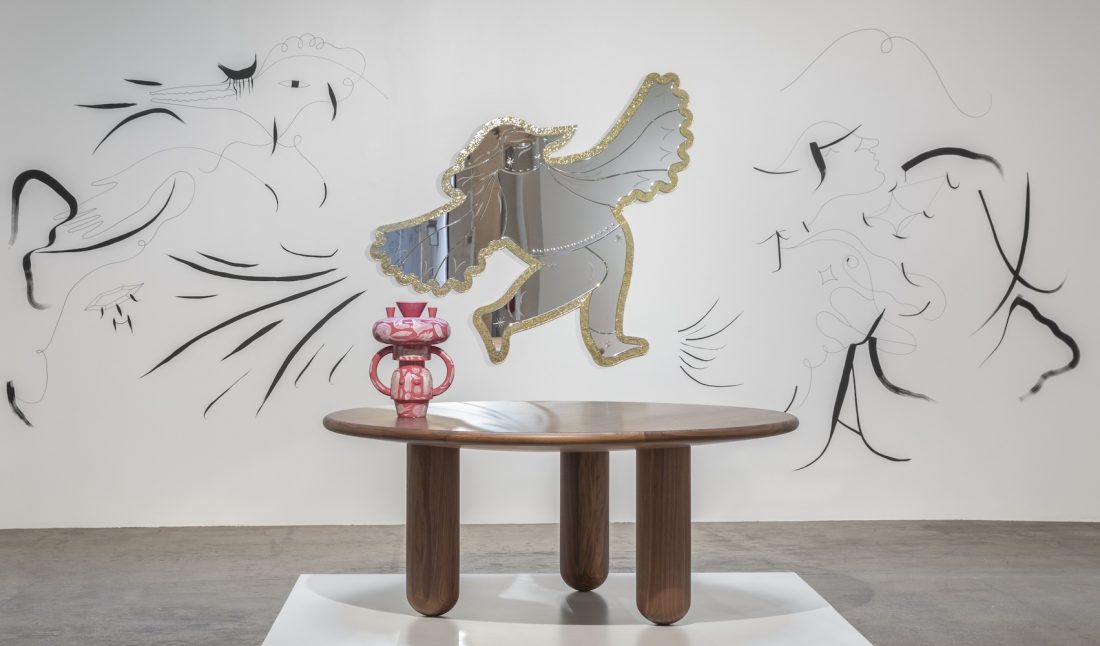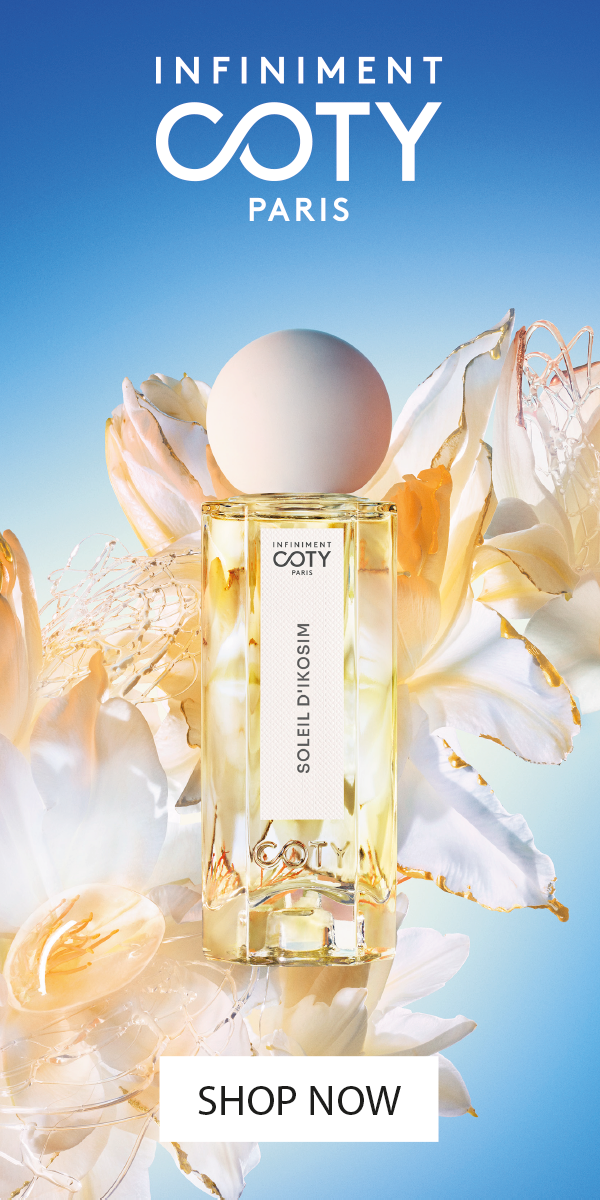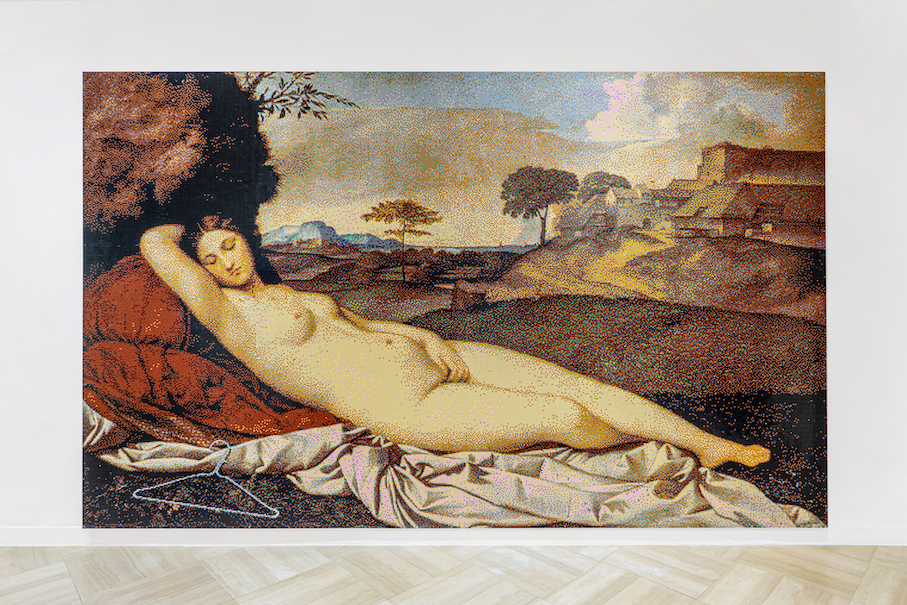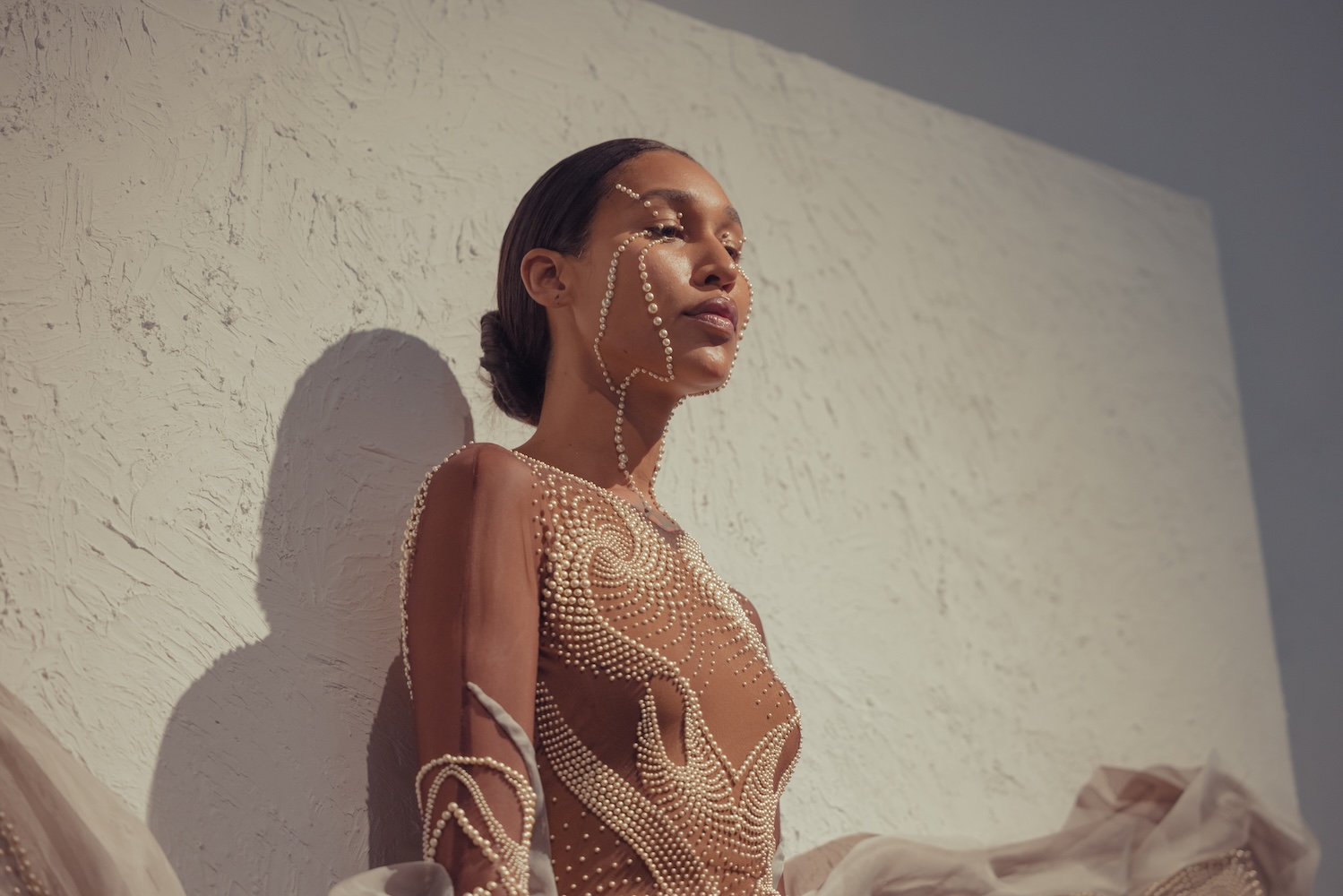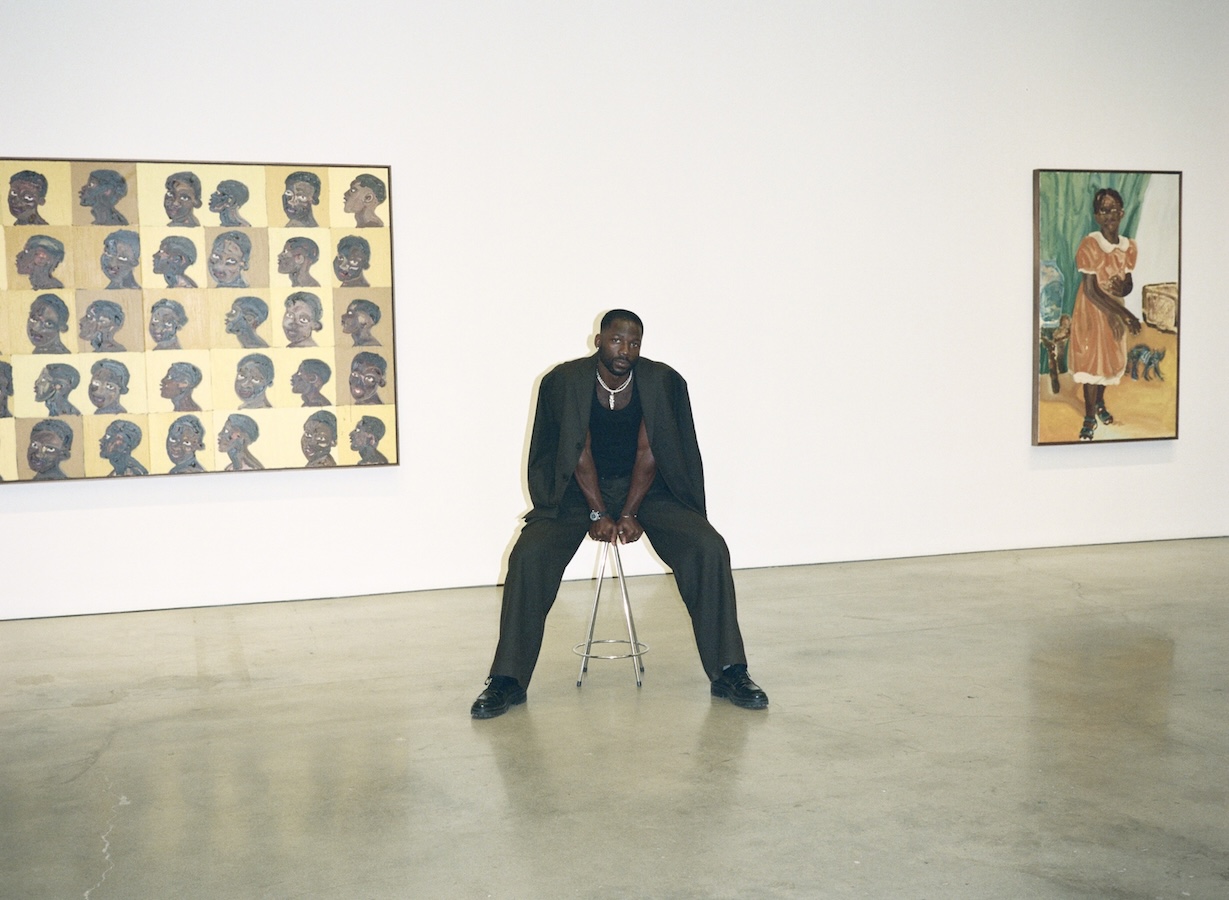This spring in Paris, Spanish artist Jaime Hayon debuted “Atelier Wonderland” at Galerie kreo, revealing 15 euphoric creations which ebb and flow throughout the gallery as a transcendent dream of art and design, on view through July 30. Utilizing his own vivacious symbols, the deft Hayon rigorously uplifts time-honored craftsmanship, and collaborates with luminaries across the world, in order to generate the expressive sculptures and paintings which brim radiantly with our inner and outer universes.
Sensual vases and lamps invoking Mediterranean color and spirit are unveiled as monochromatic masterpieces, beaming with the silken finish of an oil painting and eliciting wonder with beguiling faces and buoyant, abstract imagery. Meticulously handcrafted walnut wood tables and Murano mirrors set the ethereal scene. Developed in rich partnership with Venetian craftsmen, hypnotic mirrors take the form of the artist’s signature, otherworldly animals, inviting audiences into a new realm of possibilities. Highlighting Hayon’s proficiency across a plethora of mediums, four sweeping paintings give life to poignant landscapes, heavenly staircases, and revelatory perspectives on life, freedom, and the far reaches of the human imagination.
Recently, Whitewall had the opportunity to speak to the ever-inspired visionary about his fierce passion for timeless craftsmanship, a tenderly intuitive practice, and the magic of relentless experimentation.
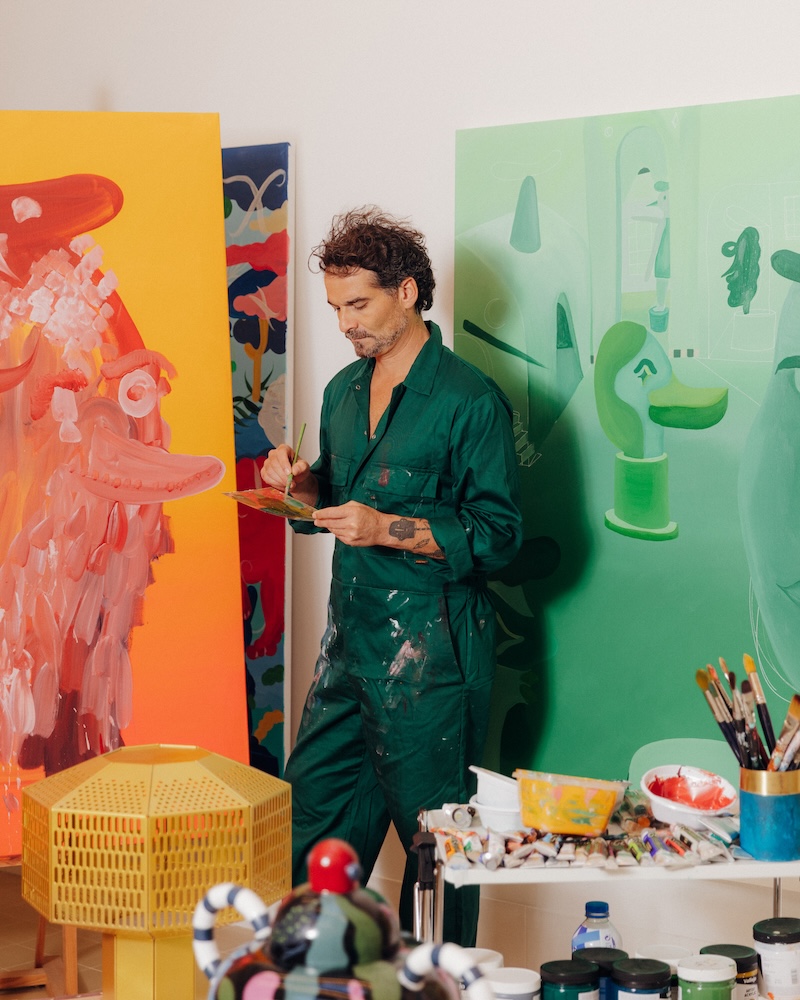 Portrait of Jaime Hayon, courtesy of the artist.
Portrait of Jaime Hayon, courtesy of the artist.
WHITEWALL: Your exhibition at Wonderland showcases a remarkable dedication to craftsmanship, blending traditional artisan techniques with contemporary design. Can you share more about your approach to marrying these two seemingly disparate elements in your work?
JAIME HAYON: Well, I’ve been doing this kind of fusion, working on this idea of extreme craftsmanship for a very long time. It’s not new to the show. I’ve been doing that since I started my career. My idea was always, I can find somebody that creates excellence in a project. I can make something very sophisticated. When I started as a ceramist, I was looking for that all the time, that guy who will make something different, or the guy that had a woodshop that could make something curvy that the others could not do, or could lacquer in a way the others could not do. For years, I think my work has demonstrated this passion of nonstop looking for who can make the best things. And not only gallery wise, but commercial wise—I work with people that make very excellent work.
In “Atelier Wonderland,” my idea was to focus on three crafts. One was inlaying with marble and wood, working with three different ateliers. There’s one atelier in France, one that’s towards Austria. They did the inlaying for me and looked for the stones—yellow marbles, green marbles, all kinds. Then I also worked with another atelier in Barcelona which was making the cabinets with little balls.
With the Venetian mirrors, I was looking for somebody that could make it exactly how they used to make it when the mirror fashions started in Venice centuries ago. It’s really hard because a lot of people are laser-cutting, other people are silk screening, engraving. It’s really hard to find ateliers. Talking to one and the other, I ended up on a little road in Murano where I found a guy who could make that. It’s not so easy, because what they mainly do—and this is how they survive—is by doing restorations to villas. They’re bringing up incredible mirrors, and when they’re broken in a villa, they’re coming up to restore it. I tried to look for the person that could make exactly like that—that was my passion.
Then, I worked with the ceramics in a place that I’ve been working for 25 years, which is in Bassano del Grappa in Italy, where they make a very specific type of earth with the ceramics. I worked there with a new technique in which I use enamel on top of glazed modern chrome ceramics, which are made with the sands of the Venice lagoon. This is their main thing.
These are the three passions of craftsmanship that I’ve been looking at for the project this time, which is extraordinary for me. It starts something, because it can go on and on. (Laughs)
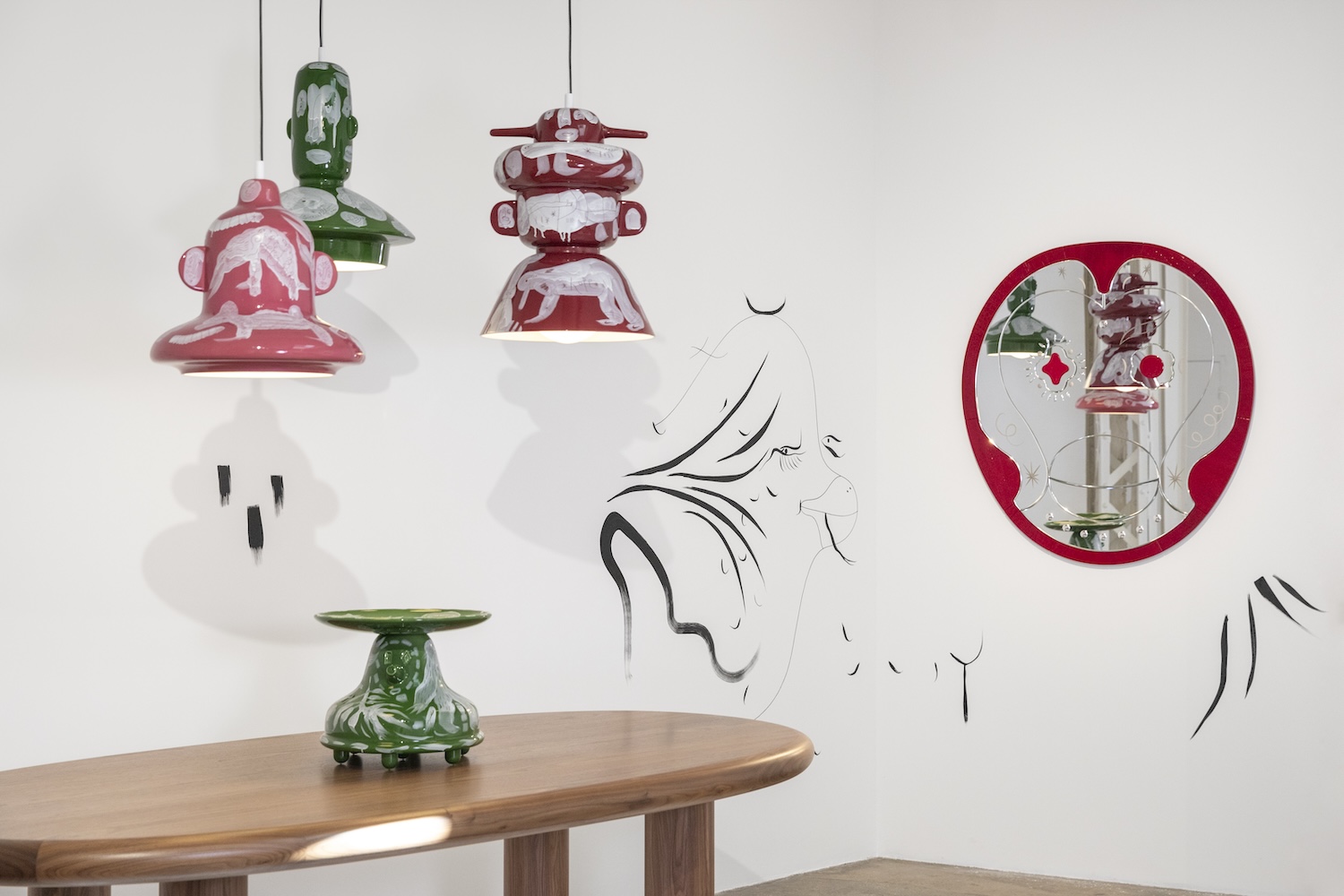 Installation view of Jaime Hayon’s “Atelier Wonderland,” © Alexandra de Cossette, courtesy of the artist and Galerie kreo.
Installation view of Jaime Hayon’s “Atelier Wonderland,” © Alexandra de Cossette, courtesy of the artist and Galerie kreo.
The Distinctive Visual Vocabulary of Jaime Hayon Unfolds in “Atelier Wonderland”
WW: The pieces in the exhibition display a vibrant array of colors, forms, and reflections in your distinctive visual vocabulary. How do you maintain career and narrative across such diverse mediums and objects?
JH: I think I’m really intuitive and my work is very intuitive. I just go for it. I just have it in my mind and look at what I have in front of me. When I decide on shapes, on forms I’m going to draw, on the specific elements that suddenly become a mirror, or a vase, or a lamp, in reality all those forms are actually coming from the cosmos. Whatever I paint, or draw, which I’m continuously doing through sketches and things, it’s very intuitive. I’m not thinking too much. I’m just kind of grabbing from my imagination and bringing it towards an idea.
For instance, I was thinking about the typical vases with two arms on them. If you look at these vases, it’s kind of distorted. I looked at the classics but I squeezed them, I enlarged them—I distorted them in my brain. It’s sort of changing the shape of it, but it’s very intuitive. In a way, colors, forms and shapes are all brought from my imaginary cosmos.
It’s really hard to explain where it comes from. I think at the end of the day, it comes from a lot of the influences I really like and things that I feel that I’m really close to. Definitely, those are the things I observe, a mix of many things. I like Japanese manga, for example. I like the Egyptian world. For me, looking at an Egyptian book, it’s full of incredible resonance to what I’m doing— and that’s what, four thousand years ago?
For me, it comes from everything I’m observing. I can be passionate about a color because I see this color as something that resonates with me, and it creates a certain type of harmony.
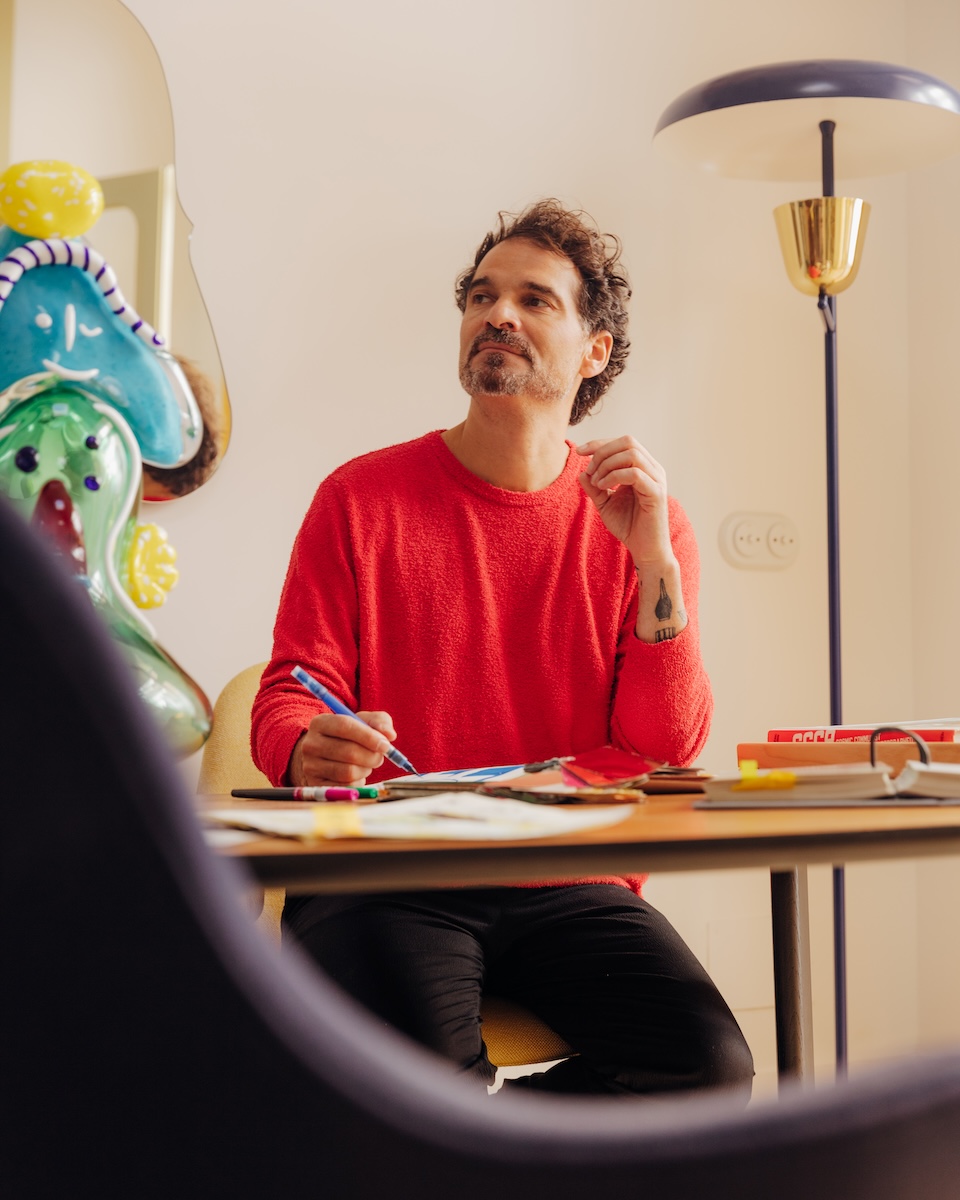 Portrait of Jaime Hayon, courtesy of the artist.
Portrait of Jaime Hayon, courtesy of the artist.
For example, now I load on the colors. I chose this palette above everything because I was working on monochrome paintings which put me into this feeling where I had to look for the reds, but I had 19,23 types of red, or I had to do 25 types of greens, to make the green monochrome. When I was doing all these greens, I was like, this is a beautiful green! That green should be the ceramic green. Or, oh, that’s an incredible yellow, can I find the marble that’s that shade of yellow? I said in the atelier, Matteo, do you think we can find marble like that? So there’s always this kind of ongoing conversation, and this is how I work.
“I can be passionate about a color because I see this color as something that resonates with me, and it creates a certain type of harmony,” — Jaime Hayon
Projects are never finished. Even yesterday when I was drawing, or having discussions with people, even having this discussion with you now, it makes me think constantly about how things can morph, where they can go. In my brain, everything’s developing.
For me, when I draw animals, they’re not animals. They’re animals I invent. They’re animals between animals. The crocodile you have in Murano is not a crocodile, it’s like a reptile but it’s a dog. It’s a mixture. But if you seek the meaning, there’s always a little bit of contradiction between them. A crocodile is something more aggressive, moves very fast, and a dog is something normal that you can trust. So having them together is quite something in terms of meaning.
WW: You’re creating your own mythology.
JH: Of course. Just take one vase and look at it—very precise. Yesterday, I was looking at it and there’s so much going on, so many things happening.
 Installation view of Jaime Hayon’s “Atelier Wonderland,” © Alexandra de Cossette, courtesy of the artist and Galerie kreo.
Installation view of Jaime Hayon’s “Atelier Wonderland,” © Alexandra de Cossette, courtesy of the artist and Galerie kreo.
An Exploratory Process of Thematics, Conversation, and Experimentation
WW: Talking about the vase, can you elaborate on your process of creating these pieces, particularly on the thematic but also on the experimentation that you did with the glaze and the alcohol to achieve that unique texture you mentioned?
JH: The interesting thing is that in the 25 years that I’ve been working with ceramics, I always try many things, but there’s always been a passion in me—how can I create silhouettes that have a background of color that is not typical?
We work with white normally, and there are all sorts of rules, you want to have a color behind, it’s really hard to go on top of it and have control of it. I thought I could work negatively. I said, this is yellow, and I prefer yellow. I’m going to go on top of it. But how do you do that?
Normally you work with enamels, but enamels have limitations because they liquify, they don’t stabilize. You cannot draw, because it doesn’t become a line, it starts to glue. I had to stabilize it. To stabilize it, I created a mixture with resin and put alcohol in it, which allowed me to have the resin glued to the piece, because it’s crystal. Imagine what would happen if you put a drop of water on crystal. It doesn’t stay. How do you make it stay? I put the water with resin, I put a little alcohol in it, the resin glues and the alcohol makes it evaporate. So it stays. In that moment, I can draw on it. It’s very magical. I tried and tried until I found that.
Now, the theme is quite interesting. I prefer sketches in which I put a lot of different symbols. My mind works like this—it’s me looking at the sky almost, and looking at the clouds, and playing the game of, what do you see? Do you see a dog, do you see a person? If I showed you how I started, you would see something, but you wouldn’t know what was happening. And then it’s like, I see something! Because that’s how the material works. It creates a sort of cloud element. You see the mirage.
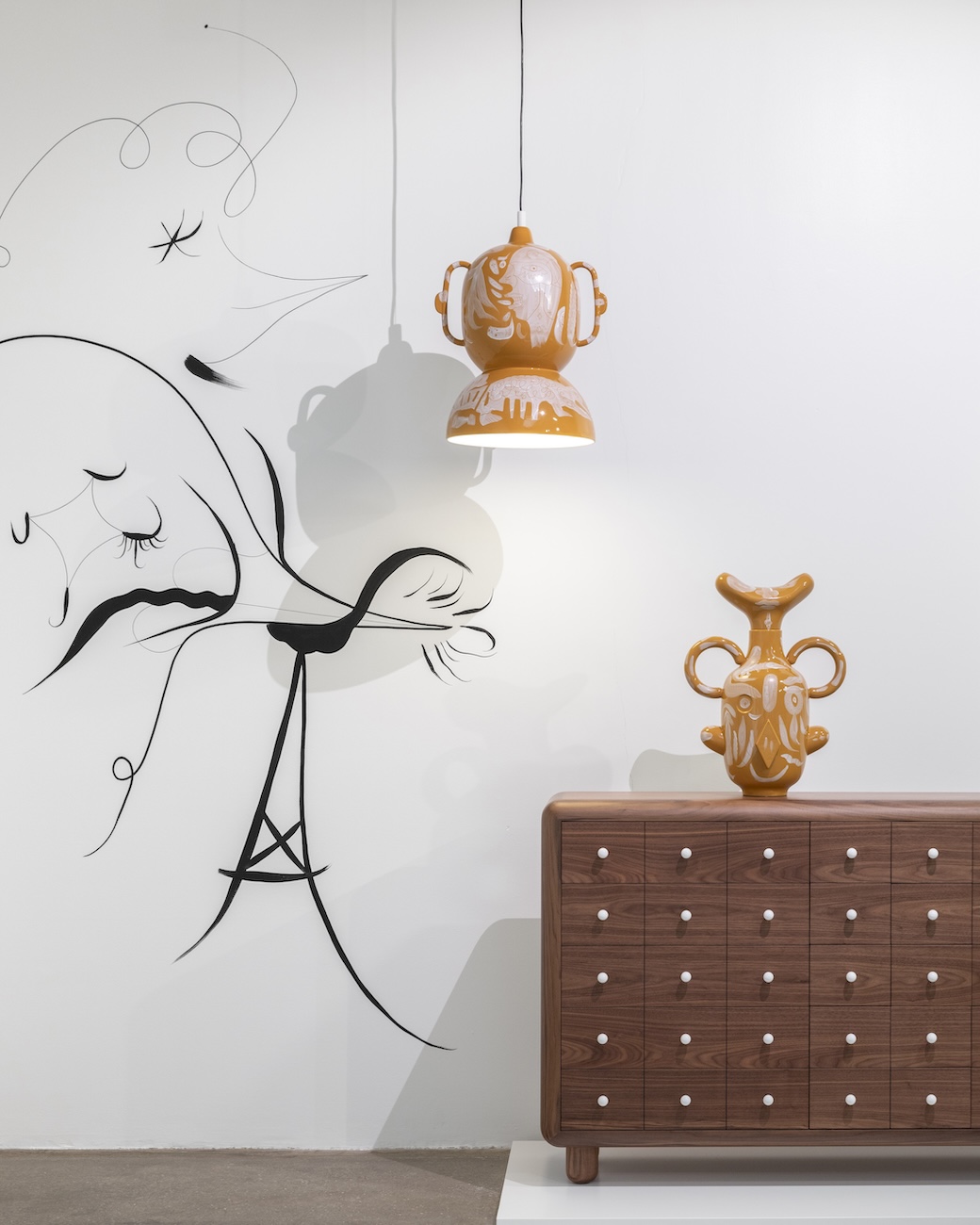 Installation view of Jaime Hayon’s “Atelier Wonderland,” © Alexandra de Cossette, courtesy of the artist and Galerie kreo.
Installation view of Jaime Hayon’s “Atelier Wonderland,” © Alexandra de Cossette, courtesy of the artist and Galerie kreo.
From there, I look at it and say, this could be an animal, this could be a person opening his hands. And then the story is, every element links to each other. I sort of call it a floating fantasy. It’s like they’re floating in space. If you look, none of the vases have anything sitting up. What I mean by sitting up is, if you look at the painting, it’s a space—there’s shadows. In the ceramics, nothing is settling. Every single element is floating. It’s like tattoos on a body. My idea was pretty much, every vase is a sky in a color, in which a lot of colors become figures. This is the process, because when I draw it, I look at it and it has no definition yet. The only definition is when I’m engraving it, and the engraving is very visceral because you can engrave with your fingers, with sticks, with a piece of something. Everything you use allows you to create an effect. It’s magical, to be honest.
It brought me, suddenly, to a very open way of addressing ceramics, which is much more visceral, much heavier. A lot of the ceramics I was doing before—many people would say, this is nice, like how Cocteau used to do them, like Picasso used to do them. I said yes, it’s true, because that’s the old way. It’s not even Cocteau or Picasso. It comes from Rome, it comes from Greece. It’s the old way.
But this is very different. Maybe they will start to copy me now. Because they haven’t tried it.
I’ve had this idea since I started doing ceramics. I did an exhibition at the High Museum in Atlanta in which I did magical, big pieces. They loved them and they acquired them for their collection. And I made them with tapestries. It was an exhibition called “Technicolor” in 2019, I think. It was a beautiful exhibition. I remember the curators at the museum, they said, wow, those are amazing, but did you ever make them in color? And I said, it’s really hard! How do you make them in colors? You have to think negatively.
I remember that moment. I never achieved it until now. By accident, actually, because I was doing a test and it worked. Total accident. That’s how you find something.
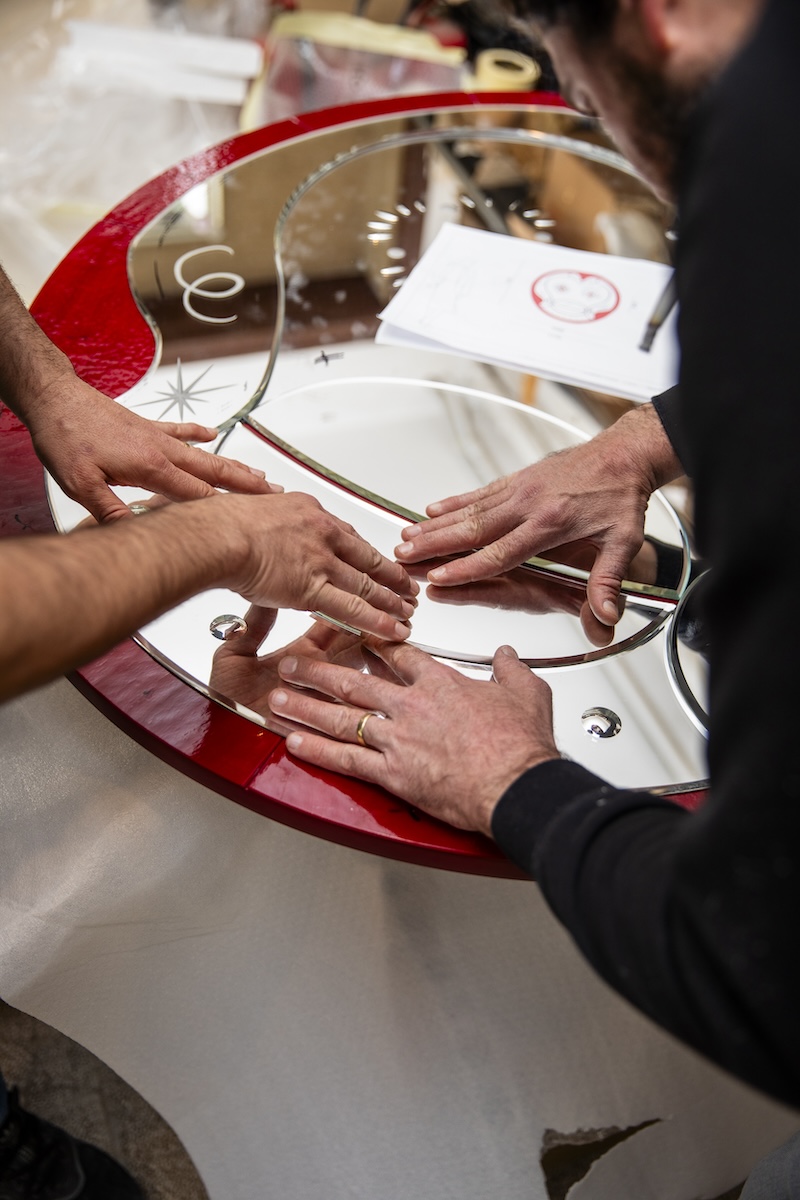 Jaime Hayon and Barbini craftsmanship in Murano, Italy; courtesy of the artist.
Jaime Hayon and Barbini craftsmanship in Murano, Italy; courtesy of the artist.
Honoring a Deep Collaboration with Masterful Venetian Craftsmen
WW: You mention in the foreword, working with artisans. I want to talk specifically about working with the Venetian craftsmen on the Murano mirrors. How did this collaboration inform your creative process, and what do you value most about working with people from such different cultural backgrounds?
JH: This is something that is probably the most important in my work. It’s searching for the person that will add to my passion but also be part of my passion. At the end of the day, I never forget that what moves me is this passion of trying, of doing, of developing the work that I’m doing—and the fantasy. The artwork I create is always seeking to find the right partner and the right people to morph into something.
The experience, for me, started with my first Murano glassworks, which are also part of different acquisitions today. This work was called “Africano.” It’s some pieces I did in which I mixed what I learned from Africa in terms of color, but I brought it to be the most refined. That is when I started to go to Murano and meet the glassblowers.
I tried with those first vases. I had conversations with the Venetians, and I said, what is it that is different about Murano, and the other crystal glass blowers, that nobody else can do? The difference is that they are working with plasticity. By talking to them, I started understanding all these pieces. I understood about color, shape, how it works, how you use different materials and so on to create these pieces.
Then, at a certain moment, I saw that also, once in a while, they’ll do mirrors. I never explored the mirror idea, only the mirror cuts. I didn’t know I could work with the cuts and the blowing together, using basically everything the cut can do but also blades of glass to create the shape and everything. This is something I learned by going there, by talking to people, by understanding their culture, and then little by little they introduced me to other people that could do that and add to it. This is how the passion started. Everything I do is an exploration of contrast, and going there, having conversations.
Conversations create the sophistication of whatever you do. So when I was there, I said, can we try one and see what happens? I even drew in my hand, and the guy that works with me said, let’s bring the shape for them so they have a puzzle they can complete and see how it works. They were happy, because this is how it used to be done. These are the beginnings of the mirrors, we made one for Basel which is even more decorative, it has blown pieces and bulbs made of glass.
“Everything I do is an exploration of contrast, and going there, having conversations,” — Jaime Hayon
WW: And we’ll see that one in Basel?
JH: I think they might put it in Basel. But even in my studio, I have a prototype. It’s really cool….with three-dimensional glass pieces even put on it, which is quite interesting.
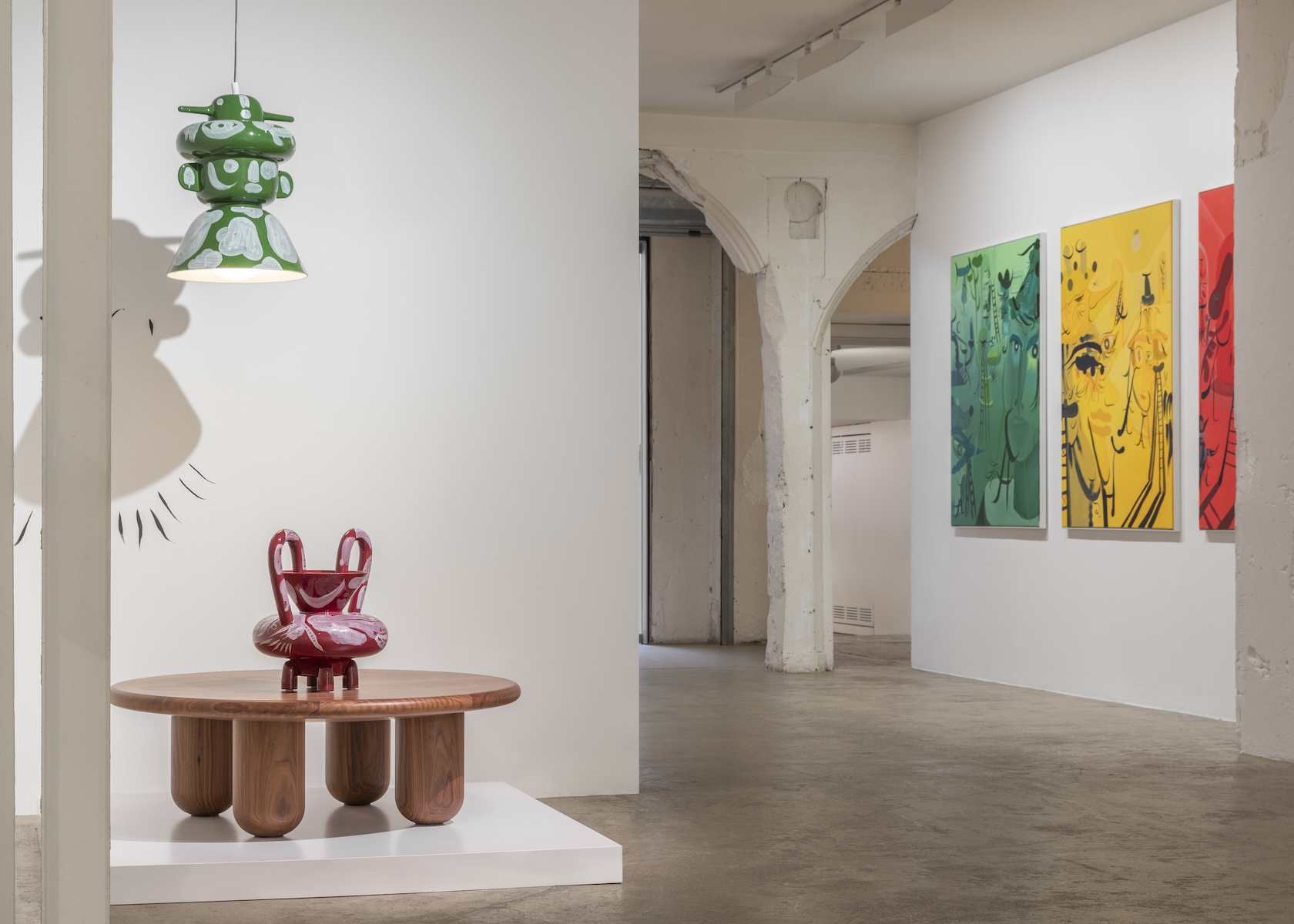 Installation view of Jaime Hayon’s “Atelier Wonderland,” © Alexandra de Cossette, courtesy of the artist and Galerie kreo.
Installation view of Jaime Hayon’s “Atelier Wonderland,” © Alexandra de Cossette, courtesy of the artist and Galerie kreo.
Blurring Boundaries Between Sculpture and Canvas
WW: Your paintings in this exhibition seem to blur traditional boundaries between sculpture and canvas, incorporating sculptural concepts and personal iconography that we’ve already addressed. Can you discuss the interplay between these two mediums? The vases and the canvases?
JH: There’s always a link. What I’m understanding with my artwork, especially with the painting, is that every day it’s more and more associated with the two-dimensional work I’m creating, which is quite fascinating for me because at the end it makes sense for everything I do.
You start to recognize in the paintings the physical world I created with three-dimensionally in these decades. I think I’m finding my way towards it by improving technique but at the same time refining this element and bringing it back.
The funny thing is, it’s called “Atelier Wonderland,” because it is my passion for the ateliers. But in the paintings, I do the same. It’s a space which is created, which is fantastical and doesn’t exist. It’s actually even distorted, because it has openings, it has sculptures sitting in there. There’s no people because the figures that you have there, which are sculptures being built, they’re interacting with each other. They become the characters, the forms.
All these staircases, for me, symbolize the different ways of looking at things. If you go on top of something, your perspective will change. It’s sort of telling you to change perspective, vision, to move you around. Also, optically, I work with the idea that it’s full black, which creates a layer in which your eyes will only look at the black and at the movement, which is actually then represented in the movement of the drones we have in the installation. For me, the idea of using monochromy is to focus very much on the composition. I did that on purpose, because normally I work with a lot of colors and the latest things I’ve done, they were full of colors, a lot of movement going on, always with the theme that is actually making you think.
“All these staircases, for me, symbolize the different ways of looking at things,” — Jaime Hayon
I did one called The Escape. I have a lot of them. They are very much thinking about this abstract idea in which the shapes and the forms are taking life suddenly in the reality of the space. It’s interesting because people that don’t know my paintings relate immediately to them. Or they understand it’s mine. It’s beautiful that they recognize you through another medium, which is very different.
I always say it’s the soul of everything, because it’s where the essence of things is. So if you take anything of that painting and you think it could be real, it’s quite interesting. You have this association and it creates a certain type of surrealism. Also, the fact that suddenly I draw in the shadows, which are the shadows that are also being created. If you look at the shadows in the painting, the shadows are not always going the same way. Sometimes they’re going straight, sometimes they’re going sideways. They’re playing with you also in that way. Everything’s coy.
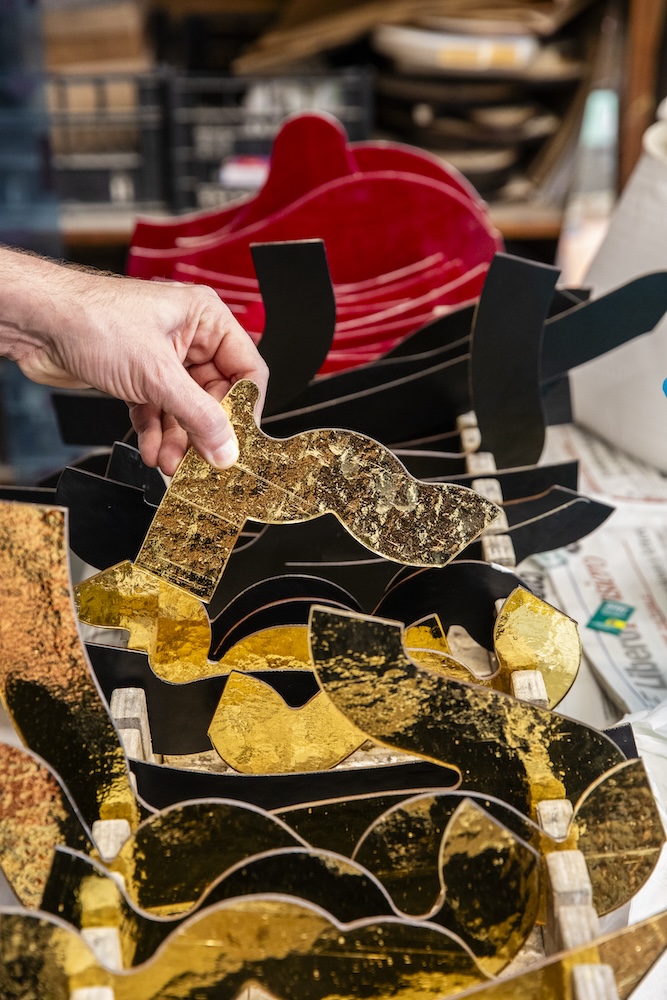 Jaime Hayon and Barbini craftsmanship in Murano, Italy; courtesy of the artist.
Jaime Hayon and Barbini craftsmanship in Murano, Italy; courtesy of the artist.
The Uplifting of Singular Artisans in Contemporary Art and Design
WW: Last but not least, “Atelier Wonderland” invites a renewed understanding of your work and reaffirms the significance of the artisans in contemporary art and design. What do you hope viewers take away from this exhibition, particularly in terms of appreciating the intersection of craftsmanship, creativity, and narrative in your practice?
JH: Well, you explained it best. That’s exactly what I want them to look at!
I think this is interesting because I keep saying to myself, people want to define you constantly. It’s really hard. Since I started my career, people have tried to compare me to someone or tried to say “you’re the new thing.” Sometime last year, someone was telling me, you’re like a new Gaudí. I’m just myself!
When I’m not here anymore and all the work is there…there’s coherence and consistency. I’ve been doing things for so many years, and I’m an artist that worked on the platform of design. I’m not a typical designer. I’m not following a brief. I’m just doing what I love and I work as an artist.
Everything I do has a narrative and a world behind it. Probably now, what I want the people to see in this kind of show is that this is freestyle. We work with the soul, bringing it directly into the pieces, bringing real artistic work into place. It’s open to interpretation. Real art to me is freedom.
I wanted it to be really dry with the tables, and to be very much in contrast with the maximized expression that the other pieces have. If you take one piece alone and you put it in any room, it’s a world. There are a lot of things happening. It’s like a painting. I call them functional sculptures because they have a function, but I’m not sure if they’re going to use them. (Laughs)
Exactly what you said is what I want people to look at. I want people to have freedom, to see the constant expression, passion, to look for perfection, improving the work, conserving the craft, and bringing it to the 21st century with another eye.
So many people use materials that are so hi-tech, trying to find reasons for what they’re doing. It’s funny, because I hear them and I say, wait a minute, so your work is interesting because you used a new material? I’m using materials that have been used since the Roman Empire. It’s the work that talks. It’s the constant narrative that’s telling the story—not the material. The material can be anything. That is important for me to express, most of all.
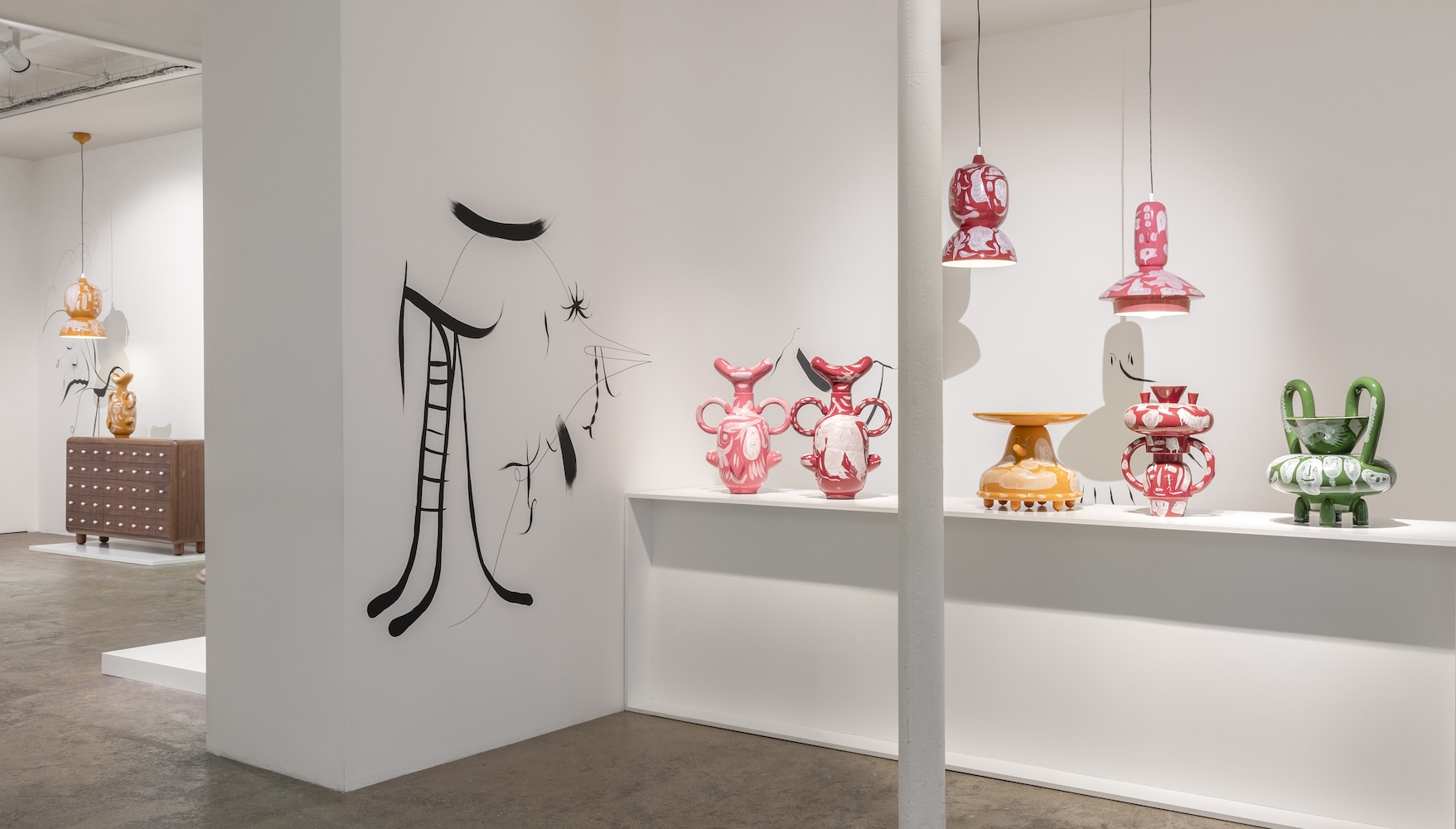 Installation view of Jaime Hayon’s “Atelier Wonderland,” © Alexandra de Cossette, courtesy of the artist and Galerie kreo.
Installation view of Jaime Hayon’s “Atelier Wonderland,” © Alexandra de Cossette, courtesy of the artist and Galerie kreo.







